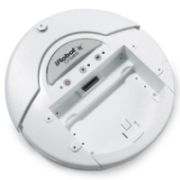Introduction to Robotics
Designing a Vehicle for Speed
Objectives
- Practice working in a team under a time constraint
- Design and build a vehicle and its propulsion system
- Improve your design after testing
Tools and Parts Needed
- Sets of Lego parts
- Rubber bands for power
Although robotic arms are used extensively in industrial applications, most people picture something more like Rosie the Jetson's robotic maid, an autonomous mobile robot, when they hear the word "robot". It is this kind of robot that we will focus most of our attention on in this course. Among other things, mobile robots are actually a type of vehicle--namely one that knows how to drive itself. In fact, it is interesting to reflect on what such a robot would be able to accomplish if it could not move around.
On robotic mobility
Because of the importance of mobility to robotics, we will focus this lab on designing a vehicle. Using parts provided, you will have 30 minutes to design and build a vehicle powered solely by a rubber-band. After this initial build time all of the vehicles will be tested. Then following the initial vehicle tests, your team may choose to modify your design to retest your improved vehicle.The design process consists of the following:
-
Requirements
Everything which is designed must meet some sort of performance requirements. In this lab, you will be designing a vehicle to maximize the distance it will travel. -
Quality
Products can be made to be of good or poor quality. In this case, you must design your vehicle to drive forward only twice, so it is not necessary that the vehicle be designed for long-term durability. -
Time
All products must be designed and implemented in a fixed window of time. In this lab you will not only be given a very short time window, but you will be given additional points for coming in before the deadline. Thus, speed is of the essence! -
Cost
Products have inherent costs in them, dependent on both the quality of the products and the time required to build the product. Good quality products usually cost more and may take longer to design/implement, whereas poor quality products usually come at a cheaper price. -
Trade offs
Engineering designs consist of trade offs between quality, time, and cost. It is how these trade offs are weighed (i.e. more weight to quality, less weight to cost to produce an expensive but very good product) that engineers need to consider before even beginning to build the desired product.
 For
this lab, all parts and rubber-bands will be supplied,
so other parts and/or rubber-bands will be disallowed. Each team will
be given
a comparable set of parts. Additional parts may also be available--just
ask.
Be sure to use good problem solving strategies, effective teamwork, and
a scientific
process for best results. Good luck!!
For
this lab, all parts and rubber-bands will be supplied,
so other parts and/or rubber-bands will be disallowed. Each team will
be given
a comparable set of parts. Additional parts may also be available--just
ask.
Be sure to use good problem solving strategies, effective teamwork, and
a scientific
process for best results. Good luck!!
The "Initial Design and Build Time" is the time designated from the beginning of the event until your proto-type vehicle is placed on display at the front of the room. No modifications to the design will be allowed once the vehicle is placed in the display area.
This lab will be assessed on the following components:- Initial design and build time
- Distance traveled on first build and on rebuild
- Demonstration of team work--individual time on task and task rotation
- Documentation quality
Your Lab Report
All lab reports should be self-contained and should contain the NAMES and their primary roles each member played at the top. Such as the following:- Lab number: L1
- Teams members: name1, name2, name3
- Time in roles:
- Scribe and Photojournalist:
- Designer:
- Engineer:
For the report, your team should discuss the answers to each of these questions. Using correct spelling and good grammar, this lab should then address the following questions:
-
Your initial design:
What were the main elements of your initial design? In particular, describe how you intended to use the rubber band for propulsion and comment on how well it worked. You may optionally use a photo or video to document how you intended to use the rubber band for propulsion in your initial design. -
Your engineering and re-engineering
In a paragraph, describe how well you were able to enact your design vision for your first attempt, and how the design changed during your testing. Be sure to discuss how your design changed (if it did.) -
Your final design:
What were the main elements of your final design? Be sure to discuss how you used the rubber band for propulsion in your final design. -
Teamwork success and learning:
In a paragraph,
describe your team's successes and failures, and what you
learned from them.
-
Comments and suggestions:
Write a paragraph that summarizes your team's reaction to this lab. Was it engaging? Was it stressful? Was it fun? If there were any problems you encountered or any questions that remain, please ask! Also, be sure to include any suggestions you have for how this lab could be improved.
Submit a Lab Report
entitled yourusername1-yourusername2-yourusername3-L1.docx
http://faculty.berea.edu/pearcej/CSC126/ | Licensed under a Creative Commons Attribution-Share Alike 3.0 United States License
